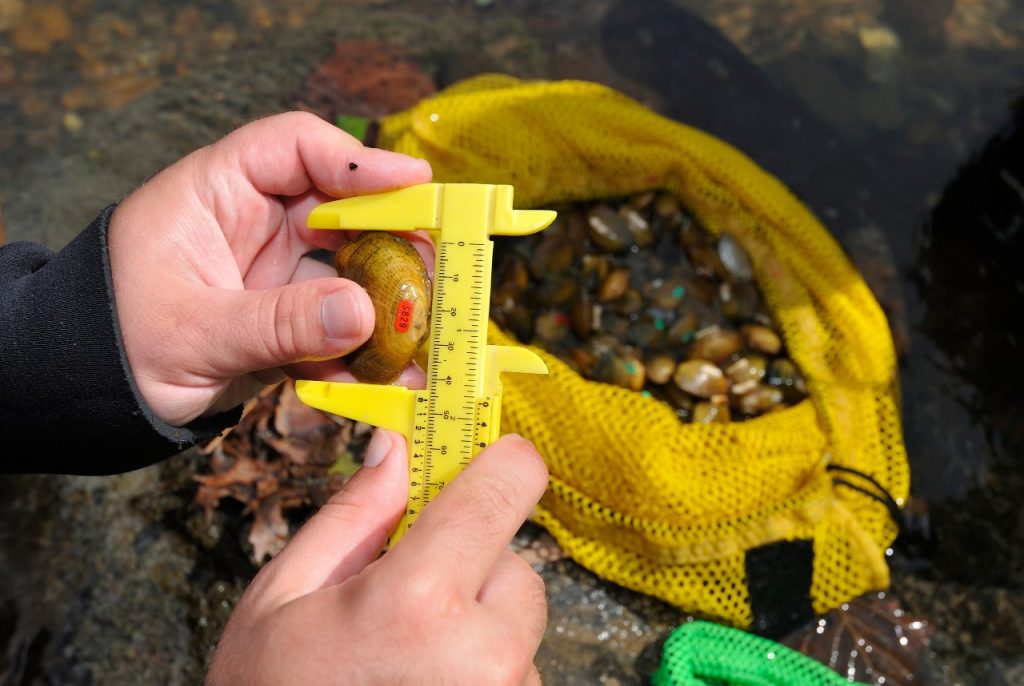
On a remote corner of campus, in tanks and constructed ponds bubbling with fresh water, an unusual life cycle is taking place.
At Virginia Tech’s Freshwater Mollusk Conservation Center, the process begins when female adult mussels release strings of larvae, called glochidia, into the water. Designed by evolution to lure fish closer by looking like food, these packets of larval mussels attach themselves to the gills of fish introduced to the tanks. In the wild, that process would provide the glochidia a way to migrate upstream against the current before detaching to start their lives as filter feeders. In the tanks, the same strange method means that a threatened species will see a boost in its population.
“We’re doing recovery work with a lot of endangered mussel species, which includes hatching them in our labs and then distributing them into water systems where there is a restoration need,” said Jess Jones, a restoration biologist with the U.S. Fish and Wildlife Service and an associate professor in VT’s Department of Fish and Wildlife Conservation. “In any given year we work with eight to 12 species, and we’ll release 10,000 to 20,000 animals into water systems in Virginia and the surrounding states.”
The process of transforming from larval mussels to juveniles takes two to three weeks. Then the mussels detach and are collected by siphoning the bottoms of the tanks. The juveniles are brought to the mussel culture facility where algae-laden pond water is cycled to feed them for one to two years until they are large enough for release into ecosystems where mussel populations have declined due to environmental degradation or pollution.
This effort is one of the many ways that the College of Natural Resources and Environment is partnering with federal agencies to serve Virginia and the nation while providing students with unique learning opportunities.
For federal scientists, having a connection to Virginia Tech means they can utilize laboratory resources and cutting-edge technologies as well as collaborate with colleagues in natural resources and environmental conservation.
“The value added is tremendous on both sides,” said Mark Ford, an associate professor of wildlife conservation and unit leader of the U.S. Geological Survey’s Virginia Cooperative Fish and Wildlife Research Unit. “The university is getting talented faculty who are bringing important research questions to Virginia Tech not only for the commonwealth, but in some cases the nation. In return, instead of doing research in isolation, federal scientists can conduct their work amidst this ideas-generating campus.”
Ford has focused much of his recent research on endangered North American bats. “Endangered bats intersect not only forest management but the energy sector, development, and even national security,” he said. “Everyone who has to manipulate something on the landscape somehow bumps into challenges of bat conservation.”
The Cooperative Research Unit, which also includes Professor Paul Angermeier, an aquatic ecologist, and Assistant Professor Elizabeth Hunter, a landscape ecologist, currently supports 19 graduate students and four postdoctoral researchers in addition to cooperating with numerous other faculty and students, both within the college and across campus. The unit is researching an array of diverse subjects, from the efficacy of best land management practices in the upper Tennessee River basin to support aquatic health, to tracking the success of reintroduced elk in the coalfields of Southwest Virginia.
“We work closely with the Department of Defense in collaboration with the college’s Conservation Management Institute,” Ford said. “The military installations in Virginia and elsewhere in the East are very actively managed, not only from a mission perspective but also from a natural resources stewardship perspective. As such, they are terrific places to acquire research data.”
In other state wildlife notes:
If you are a Virginia resident and are in possession of any species of reptile and amphibian that is 1) native or naturalized to Virginia and 2) was in your personal possession before July 1, 2021, you need to register your animals with the Virginia Reptile and Amphibian Registry.
These conditions apply to all animals regardless of origin (wild-caught or captive-bred), as well as animals obtained outside of Virginia. Individuals holding Exhibitor and/or Educator permits should also register their animals in the event you choose not to renew your permit in the future.
Cornsnake morphs (ghost, snow, fancy, and other nonnative variations) and albino animals do not need to be registered. This registry will be open only until Dec. 31, 2021. For questions, contact vaherpregistry@dwr.Virginia.gov.
For individuals with a Hold & Sell permit, which is required to captively breed and sell certain native species, the Department of Wildlife Resources will be removing scarlet kingsnake and mole kingsnake from the list and adding Northern pinesnake. The agency will also be lifting the ban on the sale and possession of Mexican axolotls. These changes became effective Aug. 1.


